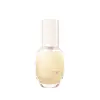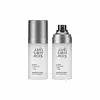What's inside
What's inside
 Key Ingredients
Key Ingredients

No key ingredients
 Benefits
Benefits

 Concerns
Concerns

 Ingredients Side-by-side
Ingredients Side-by-side

Water
Skin ConditioningDipropylene Glycol
HumectantAlcohol Denat.
AntimicrobialNiacinamide
SmoothingBetaine
HumectantGlycerin
Humectant1,2-Hexanediol
Skin ConditioningPolyglyceryl-10 Stearate
Skin ConditioningGlycereth-26
HumectantPolyurethane-15
Cetearyl Alcohol
EmollientCarbomer
Emulsion StabilisingTromethamine
BufferingCeramide NP
Skin ConditioningTriethylhexanoin
MaskingEthylhexylglycerin
Skin ConditioningAcrylates/C10-30 Alkyl Acrylate Crosspolymer
Emulsion StabilisingHydroxyethylcellulose
Emulsion StabilisingAdenosine
Skin ConditioningParfum
MaskingSqualane
EmollientPhospholipids
Skin ConditioningHydrogenated Polydecene
EmollientDisodium EDTA
Cholesterol
EmollientCalcium Titanium Borosilicate
AbrasivePhytosphingosine
Skin ConditioningTheobroma Cacao Extract
Skin ConditioningDextrin
AbsorbentCI 77891
Cosmetic ColorantCI 77491
Cosmetic ColorantButylene Glycol
HumectantPolysorbate 60
EmulsifyingDisodium Phosphate
BufferingCI 19140
Cosmetic ColorantTin Oxide
AbrasivePanthenol
Skin ConditioningCarthamus Tinctorius Seed Oil
MaskingButyl Avocadate
Skin ConditioningSodium Phosphate
BufferingEnantia Chlorantha Bark Extract
Skin ConditioningCalendula Officinalis Flower Extract
MaskingSpiraea Ulmaria Extract
AstringentPunica Granatum Pericarp Extract
Skin ConditioningTocopherol
AntioxidantPortulaca Oleracea Extract
Skin ConditioningHyaluronic Acid
HumectantOleanolic Acid
Skin ConditioningHydrolyzed Hyaluronic Acid
HumectantSodium Hyaluronate
HumectantWater, Dipropylene Glycol, Alcohol Denat., Niacinamide, Betaine, Glycerin, 1,2-Hexanediol, Polyglyceryl-10 Stearate, Glycereth-26, Polyurethane-15, Cetearyl Alcohol, Carbomer, Tromethamine, Ceramide NP, Triethylhexanoin, Ethylhexylglycerin, Acrylates/C10-30 Alkyl Acrylate Crosspolymer, Hydroxyethylcellulose, Adenosine, Parfum, Squalane, Phospholipids, Hydrogenated Polydecene, Disodium EDTA, Cholesterol, Calcium Titanium Borosilicate, Phytosphingosine, Theobroma Cacao Extract, Dextrin, CI 77891, CI 77491, Butylene Glycol, Polysorbate 60, Disodium Phosphate, CI 19140, Tin Oxide, Panthenol, Carthamus Tinctorius Seed Oil, Butyl Avocadate, Sodium Phosphate, Enantia Chlorantha Bark Extract, Calendula Officinalis Flower Extract, Spiraea Ulmaria Extract, Punica Granatum Pericarp Extract, Tocopherol, Portulaca Oleracea Extract, Hyaluronic Acid, Oleanolic Acid, Hydrolyzed Hyaluronic Acid, Sodium Hyaluronate
Onsen-Sui
Butylene Glycol
HumectantGlycerin
HumectantGlycereth-26
HumectantPropanediol
Solvent1,2-Hexanediol
Skin ConditioningPhenoxyethanol
PreservativePEG-60 Hydrogenated Castor Oil
EmulsifyingPolyglyceryl-2 Oleate
EmulsifyingDiphenyl Dimethicone
EmollientWater
Skin ConditioningTriethylhexanoin
MaskingHydrogenated Lecithin
EmulsifyingEthylhexylglycerin
Skin ConditioningParfum
MaskingSodium Citrate
BufferingDisodium EDTA
Citric Acid
BufferingOctyldodeceth-16
EmulsifyingHydrolyzed Pearl
Skin ConditioningPolyester-5
Saccharomyces Ferment
Skin ConditioningTillandsia Usneoides Extract
Skin ConditioningEthyl Hexanediol
SolventChamomilla Recutita Flower Water
MaskingOnsen-Sui, Butylene Glycol, Glycerin, Glycereth-26, Propanediol, 1,2-Hexanediol, Phenoxyethanol, PEG-60 Hydrogenated Castor Oil, Polyglyceryl-2 Oleate, Diphenyl Dimethicone, Water, Triethylhexanoin, Hydrogenated Lecithin, Ethylhexylglycerin, Parfum, Sodium Citrate, Disodium EDTA, Citric Acid, Octyldodeceth-16, Hydrolyzed Pearl, Polyester-5, Saccharomyces Ferment, Tillandsia Usneoides Extract, Ethyl Hexanediol, Chamomilla Recutita Flower Water
 Reviews
Reviews

Ingredients Explained
These ingredients are found in both products.
Ingredients higher up in an ingredient list are typically present in a larger amount.
1,2-Hexanediol is a synthetic liquid and another multi-functional powerhouse.
It is a:
- Humectant, drawing moisture into the skin
- Emollient, helping to soften skin
- Solvent, dispersing and stabilizing formulas
- Preservative booster, enhancing the antimicrobial activity of other preservatives
Butylene Glycol (or BG) is used within cosmetic products for a few different reasons:
Overall, Butylene Glycol is a safe and well-rounded ingredient that works well with other ingredients.
Though this ingredient works well with most skin types, some people with sensitive skin may experience a reaction such as allergic rashes, closed comedones, or itchiness.
Learn more about Butylene GlycolDisodium EDTA plays a role in making products more stable by aiding other preservatives.
It is a chelating agent, meaning it neutralizes metal ions that may be found in a product.
Disodium EDTA is a salt of edetic acid and is found to be safe in cosmetic ingredients.
Learn more about Disodium EDTAEthylhexylglycerin (we can't pronounce this either) is commonly used as a preservative and skin softener. It is derived from glyceryl.
You might see Ethylhexylglycerin often paired with other preservatives such as phenoxyethanol. Ethylhexylglycerin has been found to increase the effectiveness of these other preservatives.
Glycereth-26 is a synthetic ingredient and polyethylene glycol ether of Glycerin. Glycerin is already naturally found in your skin and helps keep your skin moisturized.
It is a humectant and helps add texture to products. It can make your product thicker.
As a humectant, it helps draw moisture from the air to your skin. This helps your skin stay hydrated.
Learn more about Glycereth-26Glycerin is already naturally found in your skin. It helps moisturize and protect your skin.
A study from 2016 found glycerin to be more effective as a humectant than AHAs and hyaluronic acid.
As a humectant, it helps the skin stay hydrated by pulling moisture to your skin. The low molecular weight of glycerin allows it to pull moisture into the deeper layers of your skin.
Hydrated skin improves your skin barrier; Your skin barrier helps protect against irritants and bacteria.
Glycerin has also been found to have antimicrobial and antiviral properties. Due to these properties, glycerin is often used in wound and burn treatments.
In cosmetics, glycerin is usually derived from plants such as soybean or palm. However, it can also be sourced from animals, such as tallow or animal fat.
This ingredient is organic, colorless, odorless, and non-toxic.
Glycerin is the name for this ingredient in American English. British English uses Glycerol/Glycerine.
Learn more about GlycerinParfum is a catch-all term for an ingredient or more that is used to give a scent to products.
Also called "fragrance", this ingredient can be a blend of hundreds of chemicals or plant oils. This means every product with "fragrance" or "parfum" in the ingredients list is a different mixture.
For instance, Habanolide is a proprietary trade name for a specific aroma chemical. When used as a fragrance ingredient in cosmetics, most aroma chemicals fall under the broad labeling category of “FRAGRANCE” or “PARFUM” according to EU and US regulations.
The term 'parfum' or 'fragrance' is not regulated in many countries. In many cases, it is up to the brand to define this term.
For instance, many brands choose to label themselves as "fragrance-free" because they are not using synthetic fragrances. However, their products may still contain ingredients such as essential oils that are considered a fragrance by INCI standards.
One example is Calendula flower extract. Calendula is an essential oil that still imparts a scent or 'fragrance'.
Depending on the blend, the ingredients in the mixture can cause allergies and sensitivities on the skin. Some ingredients that are known EU allergens include linalool and citronellol.
Parfum can also be used to mask or cover an unpleasant scent.
The bottom line is: not all fragrances/parfum/ingredients are created equally. If you are worried about fragrances, we recommend taking a closer look at an ingredient. And of course, we always recommend speaking with a professional.
Learn more about ParfumTriethylhexanoin is created from glycerin and 2-ethylhexanoic acid. It is a solvent and emollient.
As a solvent, Triethylhexanoin helps dissolve ingredients to stable bases or help evenly distribute ingredients throughout the product.
It is also an emollient and helps condition the skin.
Learn more about TriethylhexanoinWater. It's the most common cosmetic ingredient of all. You'll usually see it at the top of ingredient lists, meaning that it makes up the largest part of the product.
So why is it so popular? Water most often acts as a solvent - this means that it helps dissolve other ingredients into the formulation.
You'll also recognize water as that liquid we all need to stay alive. If you see this, drink a glass of water. Stay hydrated!
Learn more about Water